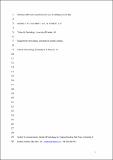Files in this item
Individual differences in preferences for cues to intelligence in the face
Item metadata
| dc.contributor.author | Moore, Fhionna R. | |
| dc.contributor.author | Law Smith, Miriam J. | |
| dc.contributor.author | Perrett, David Ian | |
| dc.date.accessioned | 2016-03-03T00:11:53Z | |
| dc.date.available | 2016-03-03T00:11:53Z | |
| dc.date.issued | 2014-05 | |
| dc.identifier | 165945516 | |
| dc.identifier | bb8b50d5-9a0b-49fc-9860-42a1506bd41c | |
| dc.identifier | 84895089230 | |
| dc.identifier | 000337780000004 | |
| dc.identifier.citation | Moore , F R , Law Smith , M J & Perrett , D I 2014 , ' Individual differences in preferences for cues to intelligence in the face ' , Intelligence , vol. 44 , no. May-June , pp. 19-25 . https://doi.org/10.1016/j.intell.2014.02.003 | en |
| dc.identifier.issn | 0160-2896 | |
| dc.identifier.other | ORCID: /0000-0002-6025-0939/work/64360944 | |
| dc.identifier.uri | https://hdl.handle.net/10023/8351 | |
| dc.description | Date of acceptance: 03/02/2014 | en |
| dc.description.abstract | We tested for individual differences in women's preferences for cues to intelligence in male faces in accordance with hormonal status (i.e. menstrual cycle phase and use of hormonal contraceptives), relationship status and context, and self-rated intelligence. There were no effects of hormonal or relationship status (Studies 1 and 2) on preferences. There was, however, a positive relationship between self-rated intelligence and preferences for cues to intelligence in the face in the context of a long-term relationship, suggesting context-specific assortment (Study 3). In Study 4, self-rated partner intelligence correlated with preferences for facial cues to intelligence. We discuss these results in the context of intelligence as a fitness indicator and suggest that future research must control for assortative mating for cognitive traits in order to better understand intelligence in mate choice. | |
| dc.format.extent | 542774 | |
| dc.language.iso | eng | |
| dc.relation.ispartof | Intelligence | en |
| dc.subject | Fitness-indicator | en |
| dc.subject | Intelligence | en |
| dc.subject | Face | en |
| dc.subject | Attractiveness | en |
| dc.subject | Individual-differences | en |
| dc.subject | BF Psychology | en |
| dc.subject.lcc | BF | en |
| dc.title | Individual differences in preferences for cues to intelligence in the face | en |
| dc.type | Journal article | en |
| dc.contributor.institution | University of St Andrews. School of Psychology and Neuroscience | en |
| dc.contributor.institution | University of St Andrews. Institute of Behavioural and Neural Sciences | en |
| dc.contributor.institution | University of St Andrews. Centre for Social Learning & Cognitive Evolution | en |
| dc.identifier.doi | https://doi.org/10.1016/j.intell.2014.02.003 | |
| dc.description.status | Peer reviewed | en |
| dc.date.embargoedUntil | 2016-03-03 |
This item appears in the following Collection(s)
Items in the St Andrews Research Repository are protected by copyright, with all rights reserved, unless otherwise indicated.

